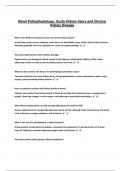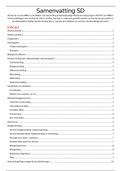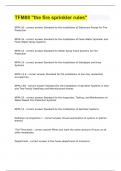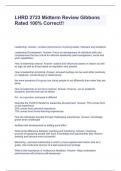Renal Pathophysiology: Acute Kidney Injury and Chronic
Kidney Disease
What is the difference between acute and chronic kidney injury?
Acute kidney injury occurs suddenly, often due to an identifiable cause, while chronic kidney disease
develops gradually over time, typically as a result of ongoing damage. ✔️✔️
How does hypertension lead to kidney damage?
Hypertension can damage the blood vessels in the kidneys, reducing their ability to filter waste
effectively, which can lead to chronic kidney disease over time. ✔️✔️
What are the common risk factors for developing acute kidney injury?
Common risk factors for acute kidney injury include dehydration, certain medications, sepsis, major
surgery, and pre-existing kidney disease. ✔️✔️
How can patients monitor their kidney health at home?
Patients can monitor their kidney health at home by tracking their blood pressure, managing their
weight, observing changes in urine output, and adhering to prescribed medications. ✔️✔️
What dietary adjustments can help manage high potassium levels in CKD?
Dietary adjustments to manage high potassium levels include reducing intake of potassium-rich foods
such as bananas, oranges, potatoes, and tomatoes. ✔️✔️
What is the role of erythropoietin in kidney function?
Erythropoietin, produced by the kidneys, stimulates the production of red blood cells in the bone
marrow, helping to maintain adequate oxygen levels in the body. ✔️✔️
How does chronic kidney disease affect metabolism?
,Chronic kidney disease can disrupt metabolism, leading to imbalances in electrolytes, acids, and waste
products, affecting various bodily functions and overall health. ✔️✔️
What lifestyle changes can help reduce the risk of developing CKD?
Lifestyle changes such as maintaining a healthy diet, engaging in regular physical activity, avoiding
smoking, and managing chronic conditions like diabetes can reduce the risk of CKD. ✔️✔️
What are the potential side effects of dialysis?
Potential side effects of dialysis include low blood pressure, muscle cramps, fatigue, infection risk, and
changes in electrolyte levels. ✔️✔️
How does glomerulonephritis contribute to kidney damage?
Glomerulonephritis involves inflammation of the kidney's filtering units, leading to scarring and
decreased kidney function, potentially resulting in chronic kidney disease. ✔️✔️
What is the importance of potassium monitoring in CKD patients?
Potassium monitoring is essential in CKD patients to prevent hyperkalemia, which can cause serious
heart problems and other complications. ✔️✔️
How can diabetes management help protect kidney function?
Effective diabetes management through blood sugar control, diet, and medication adherence can
significantly reduce the risk of developing diabetic nephropathy and preserve kidney function. ✔️✔️
What role does hydration play in preventing acute kidney injury?
Proper hydration helps maintain adequate blood flow to the kidneys, preventing dehydration-related
damage that can lead to acute kidney injury. ✔️✔️
How can exercise impact the quality of life for CKD patients?
Regular exercise can improve physical function, enhance mood, reduce fatigue, and contribute to
overall well-being, positively impacting the quality of life for CKD patients. ✔️✔️
,What are some common misconceptions about kidney disease?
Common misconceptions about kidney disease include the belief that it only affects older adults, that
it is always caused by diabetes, and that it has no symptoms until late stages. ✔️✔️
How does metabolic syndrome relate to kidney disease?
Metabolic syndrome, characterized by obesity, hypertension, and insulin resistance, increases the risk
of kidney disease due to its impact on blood pressure and glucose control. ✔️✔️
Acute Kidney Injury (AKI)
rapid loss of renal function due to damage to the kidneys; formerly called acute renal failure
•Incidence of 2% to 20% of non-ICU hospitalized patients and up to 67% of ICU patients.
– Results in an increase in length of stay, complications, & mortality.
•Mortality rate 40% to 70% among patients treated with renal replacement therapy (RRT)
•Acute kidney injury after combat trauma occurs in up to 34.3% of the most critically injured patients,
usually within the first 2 days after injury
•Patients who survive AKI and approach normal kidney function by hospital discharge are at increased
risk for later development of chronic kidney disease (CKD).
Critical care patients with AKI have a longer length of hospital stay, more complications, and higher
mortality. AKI-associated mortality ranges from 15% to 60%. One of the reasons for poor survival is that
critical care patients often have co-existing non-kidney conditions that increase their susceptibility to
the development of AKI.
**Acute kidney injury after combat trauma occurs in up to 34.3% of the most critically injured patients,
usually within the first 2 days after injury.1
Today the most frequent causes of AKI in the critically ill are associated with sepsis and cardiac surgery.
Typically a patient is not admitted to the critical care unit with a diagnosis of AKI alone; there is always
co-existing hemodynamic, cardiac, pulmonary, or neurologic compromise.
Many patients have underlying changes in kidney function, such as anelevated serum creatinine level
,although they have no symptoms. The lack of kidney reserve places these patients at increased risk for
AKI if complications occur in any otherorgan systems. As a result, thepicture of AKI in the moderncritical
care unit has changed to encompass patients with kidney injury who also have multisystem dysfunction
that complicates their clinical course.
, Risk Factors for AKI
Today the most frequent causes of AKI in the critically ill are associated with sepsis and cardiac surgery
especially with CBP (coronary bypass), this it because the MAP that you need to perfuse the kidneys is
more than what we run the machine on due to the needs for surgery. Typically a patient is not admitted
to the critical care unit with a diagnosis of AKI alone; there is always co-existing hemodynamic, cardiac,
pulmonary, or neurologic compromise.
One of the biggest things we can do is good line care to avoid sepsis.
Brainpower
Read More
What makes Sepsis and Cardiac Surgery so prone to AKI?
Today the most frequent causes of AKI in the critically ill are associated with sepsis and cardiac surgery.
Typically a patient is not admitted to the critical care unit with a diagnosis of AKI alone; there is always
co-existing hemodynamic, cardiac, pulmonary, or neurologic compromise. Many patients have
underlying changes in kidney function, such as an elevated serum creatinine level, although they have
no symptoms. The lack of kidney reserve places these patients at increased risk for AKI if complications
occur in any other organ systems. As a result, the picture of AKI in the modern critical care unit has
changed to encompass patients with kidney injury who also have multisystem dysfunction that
complicates their clinical course.
Kayexalate = used to treat high potassium in your blood.
you need to be able to know the difference between AKI and Renal Necrosis (Which is technically an AKI,
but will be considered different things)







